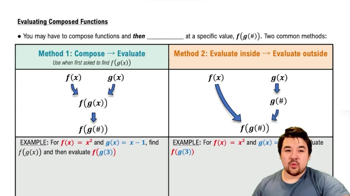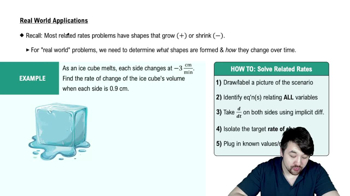Table of contents
- 0. Functions7h 52m
- Introduction to Functions16m
- Piecewise Functions10m
- Properties of Functions9m
- Common Functions1h 8m
- Transformations5m
- Combining Functions27m
- Exponent rules32m
- Exponential Functions28m
- Logarithmic Functions24m
- Properties of Logarithms34m
- Exponential & Logarithmic Equations35m
- Introduction to Trigonometric Functions38m
- Graphs of Trigonometric Functions44m
- Trigonometric Identities47m
- Inverse Trigonometric Functions48m
- 1. Limits and Continuity2h 2m
- 2. Intro to Derivatives1h 33m
- 3. Techniques of Differentiation3h 18m
- 4. Applications of Derivatives2h 38m
- 5. Graphical Applications of Derivatives6h 2m
- 6. Derivatives of Inverse, Exponential, & Logarithmic Functions2h 37m
- 7. Antiderivatives & Indefinite Integrals1h 26m
- 8. Definite Integrals4h 44m
- 9. Graphical Applications of Integrals2h 27m
- 10. Physics Applications of Integrals 2h 22m
4. Applications of Derivatives
Related Rates
Problem 2.R.2
Textbook Question
The height above the ground of a stone thrown upwards is given by s(t), where t is measured in seconds. After 1 second, the height of the stone is 48 feet above the ground, and after 1.5 seconds, the height of the stone is 60 feet above the ground. Evaluate s(1) and s(1.5), and then find the average velocity of the stone over the time interval [1, 1.5].
 Verified step by step guidance
Verified step by step guidance1
First, understand that s(t) represents the height of the stone at time t. We are given s(1) = 48 feet and s(1.5) = 60 feet. These values indicate the height of the stone at 1 second and 1.5 seconds, respectively.
To find the average velocity of the stone over the time interval [1, 1.5], use the formula for average velocity: \( v_{avg} = \frac{s(t_2) - s(t_1)}{t_2 - t_1} \), where \( t_1 = 1 \) and \( t_2 = 1.5 \).
Substitute the given values into the average velocity formula: \( v_{avg} = \frac{s(1.5) - s(1)}{1.5 - 1} \).
Calculate the difference in height: \( s(1.5) - s(1) = 60 - 48 \).
Divide the difference in height by the difference in time: \( v_{avg} = \frac{12}{0.5} \). This will give you the average velocity of the stone over the interval [1, 1.5].
 Verified video answer for a similar problem:
Verified video answer for a similar problem:This video solution was recommended by our tutors as helpful for the problem above
Video duration:
2mPlay a video:
Was this helpful?
Key Concepts
Here are the essential concepts you must grasp in order to answer the question correctly.
Function Evaluation
Function evaluation involves substituting a specific input value into a function to determine its output. In this context, evaluating s(1) and s(1.5) means finding the height of the stone at 1 second and 1.5 seconds, respectively. This is crucial for understanding the stone's position at those specific times.
Recommended video:

Evaluating Composed Functions
Average Velocity
Average velocity is defined as the change in position over the change in time. It can be calculated using the formula (s(t2) - s(t1)) / (t2 - t1). In this problem, the average velocity of the stone over the interval [1, 1.5] is determined by finding the difference in height at these two times and dividing by the time interval.
Recommended video:

Average Value of a Function
Rate of Change
Rate of change refers to how a quantity changes with respect to another variable, often time. In calculus, this concept is fundamental for understanding motion, as it relates to how quickly the height of the stone changes as time progresses. The average velocity calculated in this problem is a specific instance of the rate of change of the stone's height with respect to time.
Recommended video:

Intro To Related Rates
Related Videos
Related Practice





